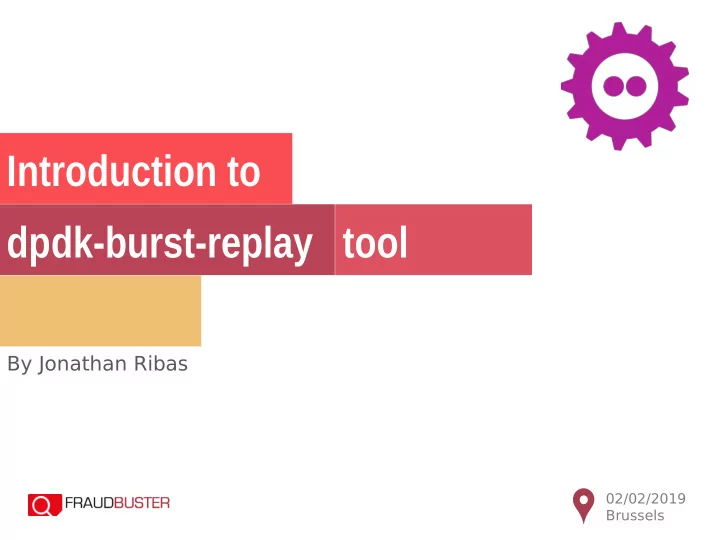

Introduction to dpdk-burst-replay tool By Jonathan Ribas 02/02/2019 Brussels
TABLE OF CONTENT 01 04 TOOL OBJECTIVES INTERNAL DESIGN 02 05 WHAT CAN IT DO? FUTURE EVOLUTIONS 03 06 HOW TO USE IT QUESTIONS?
Tool objectives 01
First, tool identity document 01 Linux command line tool Wrote in C, compiling on x86_64/arm64 archs. Use DPDK stack T o achieve maximum replay performances. Prerequisite packages dpdk-dev and libnuma-dev. Open source Available at git.dpdk.org (mirrored on github) under BSD-3-clause license. Early stage Newborn tool, please be kind :) Big community Of a single developer.. me.
Tool objectives 01 Fast I want to use maximum hardware capabilities of network interface cards and PCI bus; without being struggled by HDD I/O and TCP/IP Linux stack (main tcpreplay bottlenecks). Simple to use Only 2 needed command line arguments are needed, the fjle and the port(s): $> dpdk-replay foo.pcap 04:00.0 No need to understand or to confjgure manually DPDK. Scriptable As scripts are always useful and can facilitate continuous integration.
What can it do? 02
What can it do? 02 Load a pcap fjle Standard input format for all common dumping/analyzing/replaying tools like tcpdump, tcpreplay, wireshark etc... Put all loaded packets in cache(s) T o avoid reading the pcap fjle while its been replays. Burst packets simultaneously on multiple ports ATM, only NICs on the same NUMA can be addressed. Run the same pcap several times in a row It can be useful to extend a stress test without having to provide a bigger pcap fjle. Output statistics At the end, some stats are displayed for each ports (time spent, pkts-per-sec, total bitrate etc…) Abstract DPDK stack All EAL/mempool/ports initializations are automatically handled.
How to use it 03
How to use it 03 Be sure to have enough hugepages available Add to your grub linux cmdline: default_hugepagesz=1G hugepagesz=1G hugepages=4 to create 4 hugepages of 1GB each. Cf: https://www.kernel.org/doc/Documentation/vm/hugetlbpage.txt Bind wanted NIC ports to igb_uio Here, just use the DPDK’s bind script: #> dpdk-devbind igb_uio 04:00.0 04:00.1 05:00.0 05:00.1 Then, just call dpdk-burst-replay: #> dpdk-burst-replay -–nbruns 10000 foo.pcap 04:00.0,04:00.1,05:00.0,05:00.1 It will burst 10000 times in a row the foo.pcap fjle in the four selected NIC ports.
Internal design 04
04
04
04
04
04
04
04
04
Terminal output 04
Terminal output 04
Future evolutions 05
Some ideas of future evolutions 05 Add an option to confjgure maximum bitrate. Add an option to send the pkts respecting the timings Be able to select multiple pcap fjles at once. Optimization of memory usage. Add a Python module to facilitate scripting. Add a confjguration fjle to tune internal parameters. Waiting for YOUR needs/ideas/feedback.
THANK YOU QUESTIONS ? http://git.dpdk.org/apps/dpdk-burst-replay
Recommend
More recommend